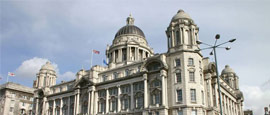Built in 1846, the world’s first enclosed, non-combustible dock warehouse system has been developed into the beating heart of Liverpool’s characterful waterfront. It’s an irresistible mix of old architecture and cutting-edge thinking. Many of the Dock’s thriving museums, galleries, bars and restaurants are housed in converted warehouses with iron colonnades. The Dock also has the largest grouping of Grade I-listed buildings in Britain.
Things to see in Liverpool
Tourist offices
Address: Anchor Courtyard, Albert Dock, Liverpool, United Kingdom
Tel: +44 151 233 2008
Opening Hours:
Daily 1000-1730 (Apr-Sep); daily 1000-1630 (Oct-Mar).
www.visitliverpool.comThe insightful, multi-lingual staff at the Albert Dock Visitor Centre can help with all visitor enquiries, including booking accommodation, restaurants, shows and concerts. There are also offices at Platform 7 of Lime Street Station, Liverpool John Lennon Airport and 112 Lord Street in Southport.
Finished in 1978, Britain’s largest Anglican cathedral is worth visiting for the stunning panoramic views from the tower alone. But set aside plenty of time to gawp at the spectacular interior too; it houses artwork by contemporary artists including Tracey Emin. The cathedral was the lifework of architect Sir Giles Gilbert Scott, who was also responsible for Battersea Power Station and the iconic red telephone box.
The city is home to two of England’s most successful football clubs: Liverpool and Everton. While a behind-the-scenes tour of Everton’s Goodison Park is a great experience, their trophy cabinet doesn’t shine like Liverpool’s Anfield collection, which is adorned with five European trophies. Tours visit the stadium’s interactive museum, dressing rooms, and go behind the scenes of the enormous new Main Stand.
Telling the story of Liverpool's great port, this splendid museum brings alive the story of mass emigration, as well as the city’s close ties to the Titanic. It focuses on the history of Albert Dock with models, maritime paintings, colourful posters and full-sized vessels. The third floor is the International Slavery Museum, dedicated to the history of the transatlantic slave trade and its appalling legacy.
This striking, ship-like museum is dedicated to local culture and history across three floors. Situated in the docks, its interactive collection explores how the people and the port have shaped the city. With sections on creative and sporting history, visitors can enjoy everything from the Beatles to football, conveyed with impassioned Liverpudlian fondness.
Part of the Tate family of museums, the Tate Liverpool is one of the largest galleries of modern and contemporary art outside of London, with works from 20th-century greats from Jean Arp to Andy Warhol. As well as presenting regular visiting exhibitions, there are tours, lectures, family events and a café designed by Sir Peter Blake.
A multilingual audio tour guides visitors through the Fab Four’s story, charting the success of the band from their early days in Liverpool and Hamburg through to international superstardom and their eventual break-up and subsequent solo careers. It includes rare photographs of the band and life-size reconstructions of the Cavern Club and Abbey Road Studios.
It makes complete sense to house the UK’s museum of popular music in Liverpool, and about 10% of the exhibition is devoted to Liverpool’s remarkable contribution to the scene. The unrivalled collection includes gems such as David Bowie’s Ziggy Stardust costumes. To add another layer of history, you’ll find it in the passenger lounge of the iconic Cunard Building.
Liverpool is blessed with more parks than Paris, of which Sefton Park is perhaps the most wonderful. With 95 hectares (235 acres) of rich parkland, boating lakes and blooming flowers to explore, this Grade I historic park is a peaceful oasis. Its centrepiece is the Victorian Palm House, built in 1896 and restored in 1993, and its surrounding statues.
Opened in 1877, the Walker Museum was founded by local brewer and alderman Andrew Barclay Walker, and now houses one of the nation's finest collections of sculptures and paintings dating from the 13th-century through to the present day, with an especially impressive collection of Pre-Raphaelite art. Peter Getting Out of Nick's Pool by David Hockney is among its highlights.
Do you have any Feedback about this page?
© 2025 Columbus Travel Media Ltd. All rights reserved. No part of this site may be reproduced without our written permission, click here for information on Columbus Content Solutions.








 You know where
You know where